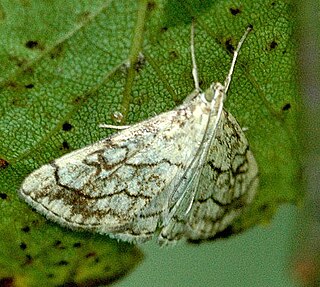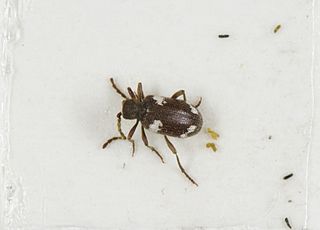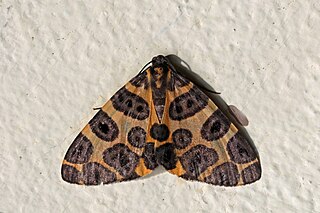| Cornifrons | |
|---|---|
 | |
| Scientific classification | |
| Kingdom: | |
| Phylum: | |
| Class: | |
| Order: | |
| Family: | |
| Genus: | Cornifrons Lederer, 1858 [1] |
| Synonyms | |
| |
| Cornifrons | |
|---|---|
 | |
| Scientific classification | |
| Kingdom: | |
| Phylum: | |
| Class: | |
| Order: | |
| Family: | |
| Genus: | Cornifrons Lederer, 1858 [1] |
| Synonyms | |
| |

Pollination of fruit trees is required to produce seeds with surrounding fruit. It is the process of moving pollen from the anther to the stigma, either in the same flower or in another flower. Some tree species, including many fruit trees, do not produce fruit from self-pollination, so pollinizer trees are planted in orchards.

Mason bee is a name now commonly used for species of bees in the genus Osmia, of the family Megachilidae. Mason bees are named for their habit of using mud or other "masonry" products in constructing their nests, which are made in naturally occurring gaps such as between cracks in stones or other small dark cavities. When available, some species preferentially use hollow stems or holes in wood made by wood-boring insects.

Osmia cornifrons, also known as the horned-face bee, are solitary bees indigenous to Northern Asia. Physically, this species of bee is recognized for its horn-like extensions originating from its lower face. Populations of O. cornifrons have been recorded in multiple locations, including Japan, Korea, China, and Russia. O. cornifrons are more docile as compared to other species of bees and are less prone to sting when aggravated.

Evergestinae is a fairly small subfamily of the lepidopteran family Crambidae, the crambid snout moths. The subfamily was described by H. Marion in 1952. It contains roughly 140 species on all continents and continental islands. Evergestine moths resemble Pyraustinae; however, the male genitalia have a long uncus and long, slender gnathos. The larvae feed mostly on Brassicaceae.
Ornativalva is a genus of moths in the family Gelechiidae.
Allotoma is a genus of moths in the superfamily Bombycoidea. The only species in the genus is Allotoma cornifrons, found in Borneo, Malaysia, and Sumatra.

Ptinus sexpunctatus is a species of beetles in the genus Ptinus of the family Ptinidae. It is commonly known as the six-spotted spider beetle.

Pantherodes is a genus of moth in the family Geometridae.
Cornifrons ulceratalis is a species of moth in the family Crambidae. It is found in Portugal, Spain, Italy, Croatia, Bosnia and Herzegovina, Albania, Greece, Morocco, Algeria and the Canary Islands.
Cornifrons actualis is a moth in the family Crambidae. It was described by William Barnes and James Halliday McDunnough in 1918. It is found in North America, where it has been recorded from Arizona, California, Montana, Nevada, Texas and Utah. The habitat consists of deserts.
Cornifrons albidiscalis is a moth in the family Crambidae. It was described by George Hampson in 1916. It is found in Kenya and South Africa.
Cornifrons phasma is a moth in the family Crambidae. It was described by Harrison Gray Dyar Jr. in 1917. It is found in North America, where it has been recorded from California and Nevada.
Ornativalva cornifrons is a moth of the family Gelechiidae. It was described by Sattler in 1976. It is found in Mongolia.

Chaetodactylus krombeini,, was described by Karl Krombein and E. W. Baker in the 1960s. The mites are about 0.5 mm across, with the females larger than the males. Pollen mites are a kleptoparasitic pest of Megachilid solitary bees, with Ch. krombeini found with Osmia lignaria of North America,. Pollen mites do not feed on bees, but rather their provisions, and are harmful because they consume the food resources and starve or stunt the developing larvae; there is evidence that pollen mites also directly harm the egg by puncturing it.
George Bunker Chapman (1925–2016) was a professor and a pioneer in research of cell biology and ultrastructure using transmission-light and transmission electron microscopy. He was the first person to see the interior structure of four bacterium species in electron micrographs he produced, described in his Ph.D. dissertation completed in 1953. As a professor, he changed the lives of 100s of students, colleagues, and others through his mentorship.
| This Evergestinae-related article is a stub. You can help Wikipedia by expanding it. |